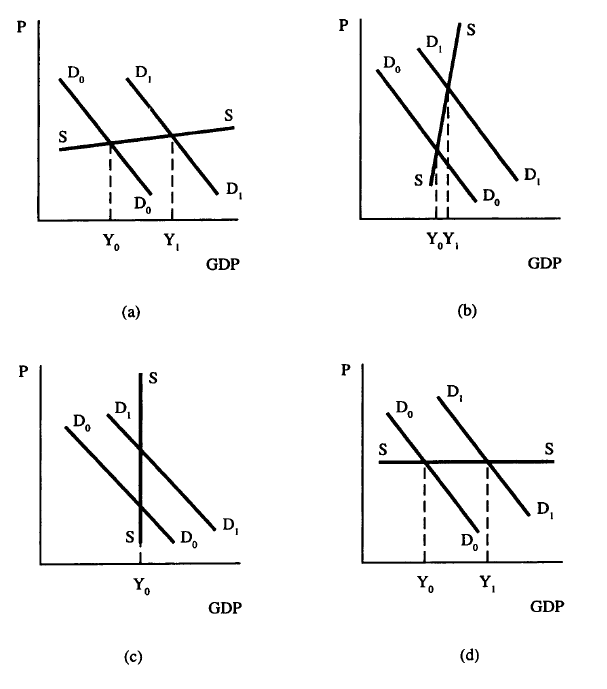
CHAPTER 10
SUPPLY-SIDE EQUILIBRIUM: UNEMPLOYMENT
AND
INFLATION?T
EST YOURSELF2. With money wages constant, as the price level rises, the real wage falls. Consequently, when prices rise, the costs of production fall in real terms; hence profits rise and firms increase output, as the positive slope of the aggregate supply curve shows.

4. The steeper the aggregate supply curve, the smaller the multiplier effect of an increase in aggregate demand, and the larger the inflationary effect. So, with an identical increase in aggregate demand, Figure 27-3(a) shows a larger output increase but a smaller price increase than Figure 27-3(b), because its aggregate supply curve is flatter. In the limiting case of Figure 27-3(c), where the aggregate supply curve is vertical, an increase in aggregate demand results only in inflation, and the multiplier is zero. In the other limiting case of Figure 27-3(d), where the aggregate supply curve is horizontal, inflation is absent and the multiplier is equal to the “oversimplified” multiplier of Chapter 26.
FIGURE 27-3

DISCUSSION QUESTIONS
1. A decrease in the price of foreign oil reduces the costs of production and thus raises the profits of firms, inducing them to produce more output. This is represented by a rightward shift of the aggregate supply curve, with a consequent increase in output and reduction in the price level.
2. The statement is overly optimistic; gaps are worrisome. An inflationary gap will eventually be eliminated, but only at a cost of the social disruption caused by inflation. A recessionary gap may not be cured at all, because the cure requires both prices and money wages to fall, and such falls are usually strenuously resisted. Even if prices and wages do fall, and the recessionary gap is eventually eliminated, the process is likely to take a long period, during which time the country will suffer from unemployment and lost output.
3. (a) Stagflation follows naturally from an increase in aggregate demand above full employment that causes an inflationary gap. Initially, prices and output rise. But later, costs rise to catch up with prices. This is represented by a leftward movement in the aggregate supply curve, which produces stagflation, that is to say, rising prices coupled with falling output.
(b) Stagflation can follow from any event that independently reduces aggregate supply, for example an increase in oil prices, weather conditions that reduce harvests or autonomous wage hikes.
4. The text lists many reasons for downward wage rigidity. Among them is the possibility that people are psychologically resistant to seeing a cut in their money wages, and therefore will resist it firmly, much more firmly than they will resist a cut in their real wages that is caused by inflation. Firms may be reluctant to incur the bad will that would be caused by wage cuts when demand falls. They may prefer to lay off a few workers rather than antagonize all, or even to keep a larger than necessary work force employed, at constant wage rates, for a period of time in the hope that demand will recover. Also, a wage cut may drive off the firm’s best employees, causing them to seek employment elsewhere at their previous wage rate. The employer is then left with the less capable employees, albeit at a lower wage rate.
5. Rising prices reduce the multiplier because the real value of wealth that is denominated in money terms declines, and this leads people to reduce their consumer expenditures. In addition, rising prices increases imports, hence reduce net exports.